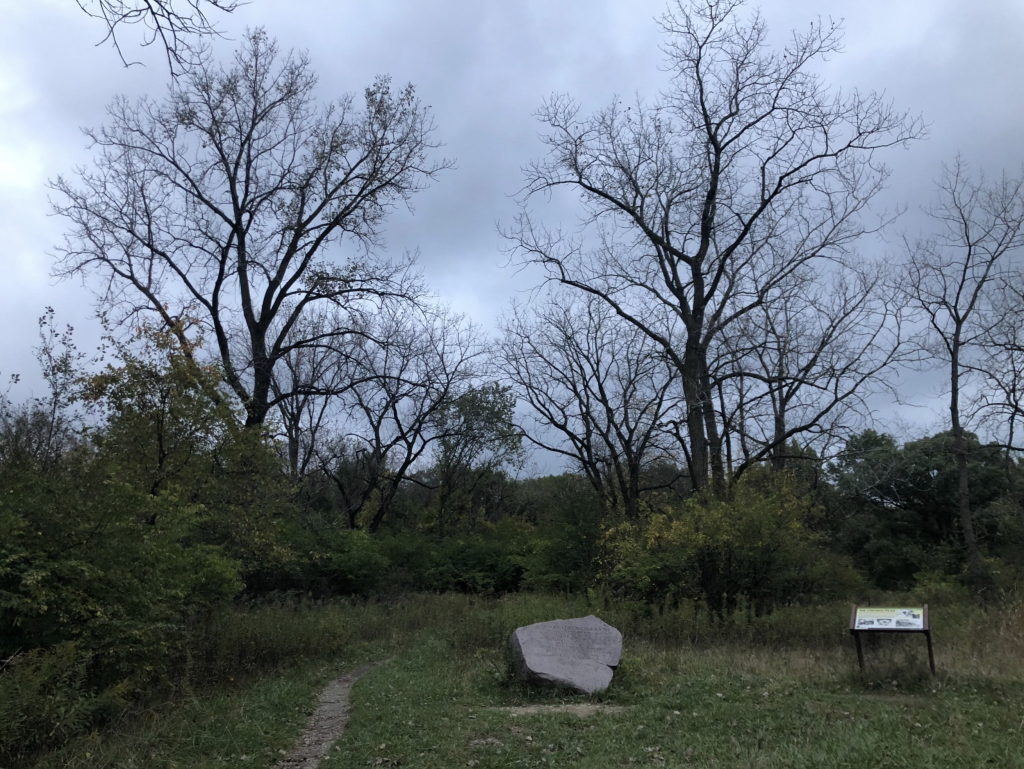Photo Tour of Red Gate Woods: Site A, Plot M, and Chicago Piles 2 & 3

By Matthew Berdyck
On December 2nd 1942, the world witnessed its first sustained nuclear reaction, introducing the planet to the dawn of atomic energy, nuclear proliferation, and high transuranic elements: human-made radioactive elements; neptunium, plutonium, americium, and others, that have atomic numbers higher than uranium in the periodic table of elements.
The reactor, called Chicago Pile 1 (CP-1) was located at the University of Chicago. Scientists quickly realized that to continue their work they would need a more isolated location than in the middle of the active neighborhood of Hyde Park. Their search for a safer location led them to Red Gate Woods, located in the Cook County Forest Preserve, where over one-thousand acres of land was leased and dubbed “Site A.”
While Site A was undergoing construction, CP-1 was briefly located at Stagg Field, at the University, under the bleachers of the football stadium. Once construction was complete, CP-1 was dismantled, moved to Red Gate Woods, and renamed Chicago Pile 2 (CP-2). Immediately, leader of the Manhattan Project, General Leslie Groves, ordered the construction of Chicago Pile 3 (CP-3), the world’s first water-cooled reactor.
The research gained from Site A led to the perfection of larger plutonium reactors. CP-2 was used to test over 75 different elements. CP-3 was used to discover the cooling effects of water with high powered reactors. All the while, the data obtained from testing was sent to Robert Oppenheimer, at Los Alamos, and used for the development of the first atomic bomb.
Across the country at the Hanford site in Washington State, the B Reactor became active, as the result of the work at CP-1, and produced plutonium for the Fat Man atomic bomb that was dropped on Nagasaki. Site A was primarily used for research purposes; reactor physics studies, hydrogen-3 recovery from irradiated lithium, fission separations, and most controversially, the study of the effects of radiation on animals.
The health risks of the work at Site A soon became apparent when one scientist’s white blood cell count dropped and stayed that way for many years. Another scientist, Harold Agnew, experienced blistered skin, amidst growing concern for the levels of Uranium oxide in the air. The scientists operating CP-2 and CP-3 soon became concerned that their work was making them guinea pigs for effects of radiation on the human body.
While the main goal of the work done at various atomic facilities around the country was focused on beating the Nazi’s to the bomb, the work also led to the development of more powerful and efficient submarines, suburban power plants, and nuclear medicine.
Eventually, far more advanced reactors were built. By 1954, CP-2 and CP-3 had become obsolete and were decommissioned. Over the next two years, the facility was dismantled. High-level transuranic waste, radioactive fuel, and heavy water were removed from Site A, disposed of at Oak Ridge National Laboratory, in Tennessee. Low level transuranic was encased in concrete and buried in a forty-foot deep hole, called Plot M.
By 1956, the Atomic Energy Commission encased the rest of the materials left from the facility in a foot-thick steel case and buried it at Site A, where a marker that appears similar to a tombstone marks the location of the reactors. Once the project was complete, the land was transferred back to Cook County Forest District and testing of the area, by the3 AEC, continued for many years.
Today, one can visit this historic site which is situated about one-mile into Red Gate Woods. Pylons mark the trail to Site A. A winding bicycle path takes visitors to the edge of the former property, where a smaller dirt path juts off and leads to the marker for Chicago Pile 2, eventually opening up into the remains of the beginnings of the Manhatten Project.
Chicago Pile 2 Chicago Pile 3 Manhattan Project Matthew berdyck Nuclear Plot M Red Gate Woods Site A














